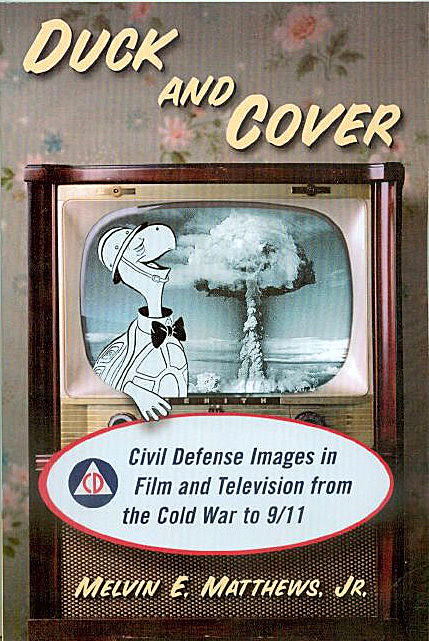
by Gene Marrano
Meticulously researched, as were his previous two books, Star-Sentinel contributing writer Melvin E. Matthews Jr. has returned with another tale of true paranoia and propaganda: Duck and Cover: Civil Defense Images in Film and Television from the Cold War to 9/11. On the cover is the friendly image of Bert the Turtle, from a 1951 Civil Defense film Duck and Cover – that told schoolchildren to get low and cover-up when they saw the flash of an atom or hydrogen bomb.
This was at the onset of the Cold War with the Soviet Union, when some were sure – or wanted others to believe – that nuclear attack from the communist Soviet regime was imminent. A decade later, during the Berlin blockade crisis when the U.S. faced off against the Soviets and East Germans, President John F. Kennedy was telling people to build fallout shelters. Ironically, a Twilight Zone episode later that same year that showed people fighting over who would gain access to such a shelter highlighted the folly of such an idea to many, and the popularity or practicality of having one in the back yard soon waned.
Duck and Cover chronicles the role that television and film had in supporting the message that nuclear attacks could be survived, despite the evidence that indeed that would not be the case in many circumstances. Rationalizing that an atomic attack was survivable would make it easier to garner support for such a program, said Matthews, who most recently wrote Fear Itself: Horror on Screen and in Reality During the Depression and World War II.
Matthews covers everything up through the Reagan era, when the anti-nuke film The Day After portrayed the stark reality of a nuclear attack aftermath, to 9/11 and what has followed during the War on Terror. But it’s the Civil Defense programs mounted in the ‘50’s, at schools, churches, town meetings and via the media to portray Duck and Cover as a viable means of survival that are the most riveting aspects of his book.
“I’ve always been intrigued by the ‘50’s,” said Mathews, “because they were so different than the ‘60’s just a short time later.” The fear of Communist subversives in the U.S. government made some sure that an atom or hydrogen bomb attack was imminent. “Everyone was expecting that to happen,” said Matthews.
Matthews does examine the films that portrayed the harmful effects of radiation – at least Hollywood style – like giant, mutated praying mantises that grew after exposure. One low budget film portrays a direct hit on New York City – many movies of that era dealt with the threat of nuclear attack but did not actually show one happening on American soil.
Matthews remembers one young classmate becoming hysterical during a duck and cover exercise at Garden City Elementary School in the early ‘60’s. “He thought a bomb was going to fall on his school and he didn’t want to stay there.” Matthews recalls repeated tests of the emergency broadcast system on the radio, which would spread the news in case of a nuclear attack: “I got so frightened I ran screaming to my mother,” he remembers fifty years later.
“Duck and Cover: Civil Defense Images in Film and Television from the Cold War to 9/11” is available from online booksellers and at Mcfarlandpub.com. Matthews will appear at a release party for his book at the Shenandoah Club on Franklin Road in downtown Roanoke, on November 29 at 5:30pm.
